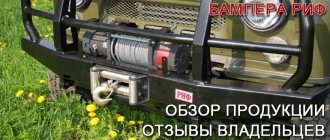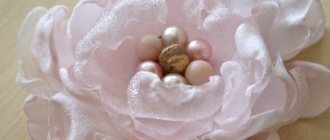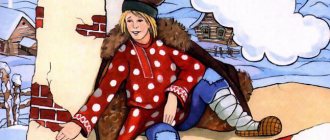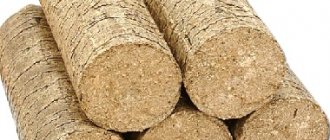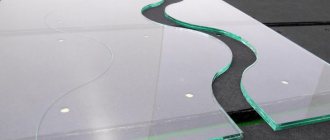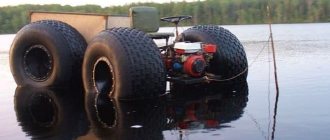In this article we will look at how to make a steering wheel braid with your own hands.
We will make a braid identical in design to the original one (it covers the steering wheel along with the spokes). For example, we take the steering wheel from a Nissan 370Z. This type of steering wheel is similar to most modern car steering wheels. This example will help you understand the principle of manufacturing the braid and rethreading of a steering wheel that has an old factory leather braid. We will also figure out how to make a braid for a steering wheel that does not have the old factory braid. Content:
- Removing the old factory braid
- Leather stretchability is an important property when making steering wheel braid
- Creating templates and cutting new braid
- How to make a template if there is no factory braid on the steering wheel
- Fastenings for manual stitching of braid (holes or stitches)
- Sewing the braid on the steering wheel (steering wheel cover)
Removing the steering wheel
The braid can be installed on the steering wheel without removing it. However, for better access to all places of the steering wheel, it is better to remove it. In some cases, removal may require a special puller (by studying the design on the Internet, you can make it yourself).
If the car has airbags, then you need to disconnect the negative terminal and wait 2-3 minutes for the power to reset in the SRS system.
Before removing, make marks on the shaft and steering wheel so that when reinstalling, the steering wheel will be in the same place.
Do not push, pull or hit the steering wheel to remove it as this may damage both the steering wheel and the steering column. More information about removing the steering wheel is written in the article “do-it-yourself steering wheel reupholstery.”
Preparatory stage
The first step is to remove the steering wheel. You will need to first remove the terminals from the battery. If the car is equipped with an airbag, then you need to wait about five minutes and then remove the steering wheel. When dismantling the steering wheel, it is recommended to follow the operating and repair instructions for the vehicle of the corresponding brand.
It is necessary to remove the old braid from the steering wheel, if any. To do this, you can simply cut it with a sharp knife along the seams, being careful not to scratch the base.
- The steering wheel is thoroughly cleaned of dirt. Then they wrap it in cling film and stick masking tape on it. All manipulations are performed very carefully, the winding should be tight, without bubbles or distortions.
- Markings are applied to a layer of masking tape with a marker or felt-tip pen. The future pattern is divided into four parts, and the markings are applied to the inside of the steering wheel. This is where the connecting seam will be. The received parts are numbered.
- The tape is cut along the marking lines and then removed from the base. After this they need to be leveled. This will help to avoid inaccuracies when cutting the material. To do this, the resulting parts are placed on a flat surface and pressed down with a weight for several hours.
An alternative solution is to accurately transfer the outlines of the resulting templates onto a sheet of cardboard. In this case, the existing parts of the future pattern should be carefully straightened and fixed on the cardboard.
Making patterns is an important stage of work; the final result of the entire work directly depends on accuracy.
Removing the old factory braid
- Examine the braid before removing. This steering wheel is made of 4 sections. It is better to mark on the old braid which section is which, since after removing and separating the braid into parts, it will be difficult to understand. In this case, the factory braid has machine stitches located 4 mm from the edges of the braid. The machine-stitched edges are then sewn by hand.
- Use a blade to remove the original braid. Use a blade to cut along the connecting seam and remove the braid. Be careful not to cut or stretch the skin when removing it.
- It is necessary to clean the surface of the steering wheel that was under the braid. This is not vulcanized rubber, which can be cleaned well with white spirit. The photo shows some glue residue that needs to be washed off.
How to make a seam
There are many options for connecting parts.
Zigzag seam
The simplest solution is lacing, which is similar in design to shoe lacing. Starting from the bottom part, I insert a needle with a strong thread into the holes prepared in advance.
- You must move counterclockwise. It is required to continuously monitor the sheathing process, carefully aligning the edges of the parts. The thread should be stretched tightly, without sagging.
- If the skin does not straighten out well, then it must be heated using a regular hair dryer. This will make it more elastic and pliable, which will eliminate the defect.
- After finishing connecting the parts, the knots must be removed inside. It is recommended to additionally glue the seam with special glue. Using a hair dryer to warm up will allow the skin to adhere thoroughly to the surface of the car steering wheel.
If desired, you can use herringbone lacing, or imitate cross stitch. Often, when reupholstering the steering wheel, the so-called “baseball stitch” is used.
Externally, the seam resembles a tie on a baseball. A similar seam is often found on other interior elements of the car. The work uses two threads, weaving them into a braid.
Hexagonal seam
This pattern is used when there are stitched seams along the edges of the parts to be joined.
- The needle and thread are passed under the parallel stitches on the parts to be joined.
- The next step is performed in one stitch (or two if the stitching on the edges is done in very small steps).
- The result is spectacular hexagons with a stripe running diagonally.
Pentagonal seam
The joining method is used when there is a sewing line on the edges of the joined elements. In this case, the stitches should be short enough.
- The needle and thread are passed alternately, each time skipping one opposite stitch.
- The thread passes into the next stitch from the reverse side.
- At the junction of the elements, interesting pentagonal-shaped segments are formed.
- This connection is known as a Euroseam, as it is practiced by many European companies.
Diamond stitch
Segments of the connecting seam in the form of diamonds, crossed by a transverse line, are formed when there are stitched seams along the edges of the parts.
It is necessary to pass every two opposite stitches, passing the needle and thread from the same side. In other words, the needle always moves in the same direction.
The choice of connection option depends on the skills and personal preferences of the home craftsman. An excellent result will be obtained in any case, provided that the work is done carefully.
DIY steering wheel braid. Leather stretchability is an important property when making steering wheel braid
Before looking at the process of creating templates and cutting out a new braid, let's figure out why the stretchability of the skin affects the production of the steering wheel braid.
The main rule of skin is that it stretches more in one direction than in the other.
If you take natural tanned leather, it will be more elastic when stretched across. In the opposite direction, the skin also stretches, but worse. Understanding this property of leather is very important when making steering wheel braid.
Not all types of leather have the same properties. Some stretch more, some less. To make the steering wheel braid, it is better to choose the most tensile leather. Parts of the old braid or manufactured templates should be laid and cut along the most stretchable side of the leather. To determine the most stretchable direction of a piece of leather, you need to pull it alternately by the edges in different directions.
In the photo, the incisions simulate the stretching of a rectangular piece of skin.
The stretch reaches a maximum at the top (outer part of the circle) and gradually decreases to zero at the bottom (inner part of the circle). The stretchability of the leather for braiding is important due to the curvature of the steering wheel. The photograph shows that the stretching process is gradual (sequential). To better understand the process, a strip of leather with identical cuts is located on top of part of the steering wheel rim. The incisions simulate the stretching of a rectangular piece of skin. The stretch reaches a maximum at the top (outer part of the circle) and gradually decreases to zero at the bottom (inner part of the circle). The thicker the steering wheel, the more difficult it will be to cover it with leather.
Materials and tools
Before sewing a steering wheel cover, you need to decide on the material. Usually leather is chosen for these purposes.
Important! Leather can be replaced with dermantine, but it quickly loses its appearance and begins to burst and crack.
Leather is a durable, dense and inexpensive material. But you should pay attention to some of its properties:
- thickness (recommended 1.5 cm);
- stretch (medium);
- perforation (this property is not for everyone, but it is very pleasant for the hands).
For tailoring, you can choose materials such as velor, suede, fur, eco-leather.
Depending on the desired effect, you should choose the fabric. If the steering wheel is too thin and you want to make it more massive, you can make a foam backing and attach it to the steering wheel.
Before sewing the braid on the steering wheel, you need to prepare a set of necessary tools:
- material;
- needle;
- thread, usually made of nylon;
- thimbles for piercing material;
- masking tape;
- felt-tip pen;
- thick cardboard;
- film in roll;
- knife or sharp razor blade.
You might be interested in making patterns and sewing toys yourself
Leather steering wheel will last a long time
Creating templates and cutting new braid
The next step in making the steering wheel braid with your own hands is to make a template using the old removed braid. Let's consider two options for preparing the old braid to create a template. These methods will help the deformed (from being on the steering wheel for a long time) removed braid to sit flat on the surface.
- The old factory braid can be soaked in water so that it becomes saturated and softened, losing the shape it took for a long time when wrapped around the steering wheel. After several hours of soaking, the old braid will be ready for cutting into segments (at the seams) and making templates. Remove any remaining thread and trim the seams. Lay the braid flat. Let it dry overnight, using weights to help prevent the skin from shrinking back. Make templates from cardboard, outlining the original braid. Next, make a blank from new leather according to the template. Use a sharp blade to cut out the blank for the new leather braid.
- For the second option of making a template, you will need cardboard and glue. You need to glue the leather segments from the old braid onto the cardboard, trying not to stretch them so that they lie on the surface naturally. Blisters will remain in the central part of the skin. This is due to the leather stretching as it fits around the steering wheel. Don't try to smooth out these bubbles so that the leather lays perfectly flat. This will only distort the braid segment. The edges where the stitches were are usually not stretched, so they should lie flat and will be temporarily held in place by glue (no need to wait for it to dry). After aligning and gluing the braid segments to the cardboard, trace the edges around the perimeter and remove the old braid segment.
- Cut the template from the inside of the drawn line (this way the template will not be larger than it should be). For this steering wheel, the top and bottom parts will be made of red leather, and the sides will be made of black Alcantara. The leather should stretch longitudinally around the steering wheel. If the leather stretches in the wrong direction, the steering wheel may end up with wrinkles.
- If the steering wheel has concave areas (usually along the back), it's best to sand them down a bit to help the glue stick there. You can use P40 sanding paper for this.
- Neoprene can be added to make the covered surface softer. When working with neoprene, you need a special glue for neoprene and rubber. Apply to the back of the leather and neoprene and allow it to dry according to the instructions. Neoprene may wrinkle a little when wrapped in a small diameter. So, to reduce this, you can leave a space in the middle of the braid to place the wrinkle. Then, when it wraps around the handlebar, the gap closes without a wrinkle.
To increase the volume of the steering wheel and the softness of the braid, you can use neoprene. To prevent it from forming a wrinkle when covering the steering wheel, you must first make cuts in the center. When covering the steering wheel, these gaps will shrink and wrinkles will not appear.
- Take a strip of leather and cut it so that it fits perfectly around the perimeter of the steering wheel. This step is important if you additionally thickened the steering wheel with some kind of backing (in this example, the old braid was glued back onto the steering wheel to increase the thickness of the steering wheel), but even without thickening it will help ensure that the braid fits the steering wheel perfectly. Using this strip, check the width of the outlined braid segments and, if necessary, adjust.
- Trace the templates onto the new leather and cut it along the inside of the outlined line.
- It's best to always test the cut segment by wrapping it around the handlebar where you expect it to be installed. This will help ensure that the cut segment fits well. Repeat this process for the remaining sections. By trying each section on after cutting, you can cut off any excess if necessary. At this stage, each section can be adjusted or redone if necessary. Once you start sewing, it may be too late to redo anything.
- When upholstering your steering wheel, it is important that the leather fits perfectly. It is important to especially carefully check the joining of the braid in the places of the knitting needles.
- The braid segments are stitched on the reverse side, after which the remaining skin is trimmed as close to the seam as possible. All sections together should be smaller than the actual diameter of the steering wheel. The key to a good fit is a slightly smaller braid.
Why do you need a steering braid?
You've probably wondered more than once: why do we need a braid at all, if the steering wheel can simply be painted in the desired color? To begin with, it performs a decorative function. You can choose the appropriate material and color scheme and thereby refresh the car interior. The braid also has other useful functions. For example, it increases the thickness of the steering wheel, making the grip more comfortable. The material will be soft under your hands and, in cold weather, warmer than the original plastic handlebar.
braid reliably protect your steering wheel from mechanical damage
In addition, the braid protects the steering wheel itself from mechanical damage: scratches, chips, abrasions. If the material has deteriorated during use, the braid can be easily removed and a new one installed, while the steering wheel itself will have to be restored for a long time and carefully. If you get a used car whose steering wheel no longer boasts a factory look, such a cover will help hide all the imperfections.
Another important feature: the braid will provide reliable grip between the surface of the steering wheel and your hands. Your palms will not slip while driving, which means your trips will be safer.
The appearance of the steering wheel has become much more expensive; it now looks like on cars of a higher class. I would also like to especially note that the steering wheel has become thicker, not as slippery as before, and most importantly, it is now pleasant to the touch. In short, I'm happy with how it turned out, including the price tag and ease of installation.
Arseny
https://www.drive2.ru/l/3031715/
How to make a template if there is no factory braid on the steering wheel
There are times when you need to make a steering wheel braid with your own hands, but the steering wheel does not initially have a factory braid. In this case, you can use the following technique. The steering wheel, including the spokes, is covered with paper adhesive tape (painting tape), after which cut lines are drawn, along which the pasted tape is then cut into segments (which must first be marked to which location they belong).
The leather is then cut into these segments, stitched together, and then on the steering wheel.
To prevent the masking tape from tearing into pieces when removed, you need to stick adhesive tape over it. This will serve as a holding backing for the masking tape. You don't need to do many layers. One layer of paper tape and one layer of tape will be enough. After removal, the template will be full of folds and wrinkles. This is normal, genuine leather cut using these templates will stretch and will not wrinkle.
Kinds
When choosing a braid for your steering wheel, you will be faced with a wide variety of materials. Among the most popular types are the following:
- braids made of natural and artificial leather;
- fur braids;
- wire braids;
- silicone pads;
- foam covers.
Useful braids can be identified as a separate category: in addition to their main functions, they have a number of additional advantages. These include, for example, heated steering wheel covers and massage pads. Let's look at each type in more detail.
Leather braids
As we have already noted, both natural and artificial leather are used to make braids. Of course, genuine leather will be more durable, softer and more pleasant to the touch than artificial leather. However, its price can be 3-4 times higher, which makes it inaccessible to many motorists. Both artificial leather (also called eco-leather) and natural leather have good performance characteristics. Such material will not fade in the sun and will not swell from moisture. He is not afraid of temperature changes.
Typically, leather cases are chosen by males. This material looks solid and expensive and fits into the interior of any car. A leather case can be a good holiday gift.
When choosing such a braid, give preference to perforated leather. It is softer to the touch and allows air to pass through better, creating a breathable effect.
perforated leather is much softer than regular leather
Fur
The fur used for steering braids can also be artificial or natural. Natural fur retains heat better in cold weather. Although, if you don’t ride around Arctic cities, then artificial material will do just as well. Sheepskin is often used to make covers.
Sheep fur is very popular for making steering braids
Faux fur with long pile is often dyed in bright colors and complemented with fun elements. Using such a cover will give off a cheerful and carefree personality to the car owner. Such braids are most often chosen by young women.
a fur braid with long multi-colored pile will look cute in the interior of a woman’s car
Wicker covers
Wire woven covers are also called retro braids because they were very popular in the middle of the last century. Now such braids are used by those who want to style their iron horse as a classic car from the times of the Soviet Union.
Wicker covers retain their main functions: protecting the steering wheel from damage and from slipping of your hands. At the same time, their price is much lower than that of leather and fur counterparts. The most popular material for making wicker covers is ordinary insulated wire, which can be found in almost everyone’s garage. Some craftsmen make braids from hard and thin clotheslines.
To decorate your car in retro style, use a wire woven cover
Wire braiding can be ordered from special workshops, or you can make it yourself using weaving patterns. Using different colors, you can create your own unique steering wheel design.
Silicone and foam covers
Silicone or foam rubber is often used to make steering braids. Manufacturing technology helps make cases made from these materials inexpensive, but capable of performing all tasks perfectly. The color range of such braids is very diverse: you can find both calm pastel shades and bright neon tones. Foam rubber covers are often printed with a colored pattern, and transparent silicone will protect your steering wheel, but will reveal its original appearance.
silicone braids can be either bright or more muted shades
Useful braids
Useful covers, as mentioned earlier, include heated braids. Any material can be used in their manufacture, but most often it is natural or eco-leather. Simply connect the wire from the case to the cigarette lighter, and you are provided with additional heating for your palms.
additional heating inside the steering braid will make driving in winter more comfortable
Braided massage inserts are usually made of rubber. The special relief affects certain points on the palms, improves blood circulation, thereby preventing fatigue and numbness in the hands.
massage inserts on the steering braid have a positive effect on blood circulation in the hands
Holes at the edges of the braid
Holes along the edges of the braid can be made manually. To do this you need to use an awl with a round tip. Using a ruler and wax pencil, mark the distances between holes and edges (5-6 mm between holes and 4 mm from edge to hole). There should be the same number of holes on both sides. You will get approximately 600 holes. This is quite labor intensive. The holes can also be made with a sewing machine using a needle without thread and having a rounded tip. You will get perfectly positioned holes without applying much force.
Uncover
After completing the work on creating the patterns, you can begin cutting. The prepared material is placed on a flat surface, the markings are applied to the wrong side.
When cutting, allowances for connecting seams should be left within 1.5-2 mm. Each part should be labeled to avoid confusion.
When working with genuine leather, it is recommended to cut it on a flat surface with a sharp knife or blade. This will allow you to get an even and neat cut.
Stitches along the edges of the braid
Another option for attaching a hand seam is to use a sewing machine to sew lines 3–4 mm from the edges of the braid.
The standard size of such stitches is 6 mm in length. If your sewing machine does not give such a length, then the distance may be different (4-5 mm). For this, T‑138 thread is used. A thinner thread will not hold the tension once you start sewing by hand. The beginning and ends are secured with no more than two stitches.
Rules of care
Proper care of the braid will extend its service life.
It is recommended to periodically clean stains with mild detergents that do not contain aggressive chemical components.
A special conditioner will help protect natural leather from drying out and cracking. It is applied to the surface of the steering wheel and then rubbed with a soft cloth.
What needle and thread should I use?
Use a needle with a blunt tip. It should be large enough to work comfortably, but small enough to fit through the stitches along the edges of the braid. You can blunt (sharpen) the edge if necessary. You can also bend the needle about 15 degrees, which will help you work in tight spots on the handlebars.
The thread should be 0.7–1 mm thick. For the best look, it is not advisable to use too thick a thread. You can use threads of different colors. Polyester thread is better than nylon thread because it resists UV radiation from the sun better.
You can use waxed threads. Wax prevents abrasion and increases the durability of the thread. If you can’t buy waxed threads, you can cover them with beeswax yourself. Spread the wax over the surface of the thread and rub the thin paper back and forth several times to saturate the thread and remove any residue.
Upholstery color and thickness
When choosing a color, it is better to focus on classic tones. Another guideline may be the special color scheme of the interior.
Note! If you choose a color according to the trends of the season, in just a couple of months it may go out of fashion. Classic colors will always be in fashion.
Bright colors can distract the driver when driving. And diversity quickly gets boring. Light colors entail frequent cleaning of the interior. Therefore, for drivers with “working” professions, it is better to choose dark shades.
Thin skin will quickly break through, and thick skin will be inconvenient for those with thin hands. Therefore, the thickness is selected purely individually. It is recommended to choose a medium size, approximately 1.5 cm.
Important! For those with massive hands, it is better to choose a skin thickness of about 2 cm for comfort.
Another important property of the material is stretchability. If the product stretches while wearing it, it will not look entirely aesthetically pleasing. Therefore, it is better to choose medium stretchability. Before sewing, you can wet and dry the selected material. This will let you know how much it shrinks or stretches.
Models made from combined colors look great
What stitch should I use to sew the braid on the handlebars?
Depending on the type of fastening at the edges of the braid (holes or stitched lines), different seams are used. To connect the edges with the holes, either a simple zigzag stitch using one thread or more complex stitches (cross stitch, baseball stitch) can be used.
To connect the edges of the braid with the stitched lines, the needle can weave the thread differently between the stitches on the edges, producing seams of different types (zigzag, pentagonal, hexagonal, diamond-shaped). The various seams for re-upholstering the steering wheel are discussed in more detail in the article on re-upholstering the steering wheel.
Selecting material for steering wheel reupholstery
Success depends to a large extent on the correct selection of material. The best option is genuine leather, which is distinguished by its durability, aesthetic appearance and a fairly large variety.
- When choosing, take into account the thickness of the material. Skin that is too thin is not interesting from a practical point of view.
- It is easier to work with, but this steering wheel braid will not last very long.
- Thick skin is difficult to pierce with a needle, so the work will take a lot of time and effort.
- The best solution is a material of natural origin with a thickness of about 1.3 mm.
It is necessary to find a sufficiently elastic material; medium elongation guarantees an excellent fit of the cover to the steering wheel.
The presence or absence of perforation is not a prerequisite. But smooth leather without unnecessary marks will last longer.
Additional materials and tools
It is recommended to stock up in advance everything you need to reupholster the steering wheel with leather. This will allow you not to be distracted while working.
In addition to genuine leather you will need:
- Needle;
- Durable nylon thread;
- Cling film;
- Masking tape;
- Marker (felt-tip pen);
- Sharp construction knife.
Given the specific features of the material, a thimble to protect your fingers will be useful.
Basic parameters for selection
In order to determine the required size of material for the braid, you do not need to remove the steering wheel. It is enough to take a tailor's meter and take measurements along the outer part of the rim . This will be the basic setting. You also need to measure the diameter of the rim to determine the required width of the upholstery strip.
In this case, an addition of 3-5 mm per seam is taken into account. Most often, the outer diameter is in the range of 35-41 cm. A smaller steering wheel is typical for sports cars, and a larger diameter is preferred for luxury cars. In addition to aesthetic perception, there are legally approved standards for steering wheel sizes.
Types of lacing with nylon thread
According to Russian GOST, the rim diameter should not exceed 40 mm.
Not all traffic police officers are on duty with calipers to take measurements, but if there is an obvious discrepancy, you can be punished for such an excess.
Heated steering wheel designed independently
One of the design options for the steering wheel is its heating. Let's take a closer look at how to make your own heated steering wheel. It is done primarily on mid-segment cars. Some modern premium models have this feature built-in.
But heating can also be done independently with the help of specialists by visiting a car workshop, or you can purchase a ready-made heating system and install it.
There is also the option of heating yourself. To operate, you will need a heating system with automatic heating mode.
The steering wheel must first be removed and then updated. First of all, you need to outline the installation location of the system. Then, in the marked places, recesses are made for the elements.
Experts suggest attaching the elements with glue and sealing them with sealant. Then its surface is puttied and leveled with a knife.
You can connect the system using a cigarette lighter, through special wiring, or use unused wires.
The safest connection option is to connect using special wiring. Using this connection option, you can simply arrange a heated steering wheel.
How to make braid lacing strips
Leather lacing strips will look much more interesting on the steering wheel than a nylon cord. But for such lacing you will need 2-3 meters of a narrow leather strip. It is not always possible to cut them out of leftover leather, especially if you make a braid from small pieces of leather. Then take advantage of these tips. Take a section of skin with a diameter of 8-10 cm. Tie a helium pen to the knitting needle (with tape). Place the point of the knitting needle in the center of this piece so that the pencil also touches the surface of the skin. Start drawing a spiral with a pencil, aligning the spoke with the already drawn spiral line. This will serve as a guide for the spoke. This way you can cut a fairly long piece of lacing from a small piece of leather.
The width of the leather strip for lacing must be at least 3-5mm.
Correct selection of future braid
The choice of upholstery determines the method of its fastening, further care for it, as well as the durability of the selected material.
Leather braids
It is customary to use natural leather as upholstery material. It is more durable and practical to process. The material is selected with or without perforation. The presence of holes helps to add volume to the product and is also an additional decoration. It also slightly visually smoothes out possible surface unevenness or minor technical problems during processing.
Leather is the most comfortable of materials due to its performance qualities.
It is easy to care for and is also more hygienic than other braid options. This point is especially relevant in cases where the car has several drivers. The leather steering wheel can be easily wiped with an antiseptic solution before driving. This procedure is not dangerous for the material, but will protect you from receiving “unwanted surprises.”
High-quality material may initially scare you off due to its price. However, you should not skimp on such an important part of the car. The price will pay off with a long period of use, a good mood while driving and easy care.
Fur braids on the steering wheel
The use of fur braids only in the first couple of days can be of interest; then such an impractical and easily soiled material will bring more negative emotions when driving. The fur quickly wrinkles in areas of the most intensive use. The pile also gets dirty too quickly and loses its aesthetic appearance, especially light colors.
Fur braided steering wheel
A large amount of dust and dirt gets stuck between the fibers , which reduces the level of hygiene for such a frequently used control. In summer, hands quickly sweat, the pile can also get wet, which causes slippage when controlling. This factor can affect the safety of driving a vehicle.
Braided wire braids
Wire braids were once fashionable on cars. They were often used to decorate mainly domestic VAZ models. The practicality of this option lies in the relative strength of the plastic wire winding. It rarely wore out even with intensive use.
However, compared to artificial leather or genuine leather, the woven base is not as attractive and not hygienic enough . Dirt quickly collects between loose coils and is not so easy to remove. The use of solutions with household cleaning chemicals helps to restore a neat appearance.
Braided braids for VAZ
In winter, such material quickly “stiffens” and warms up poorly. You have to use gloves while driving.
Useful braids on the steering wheel
By making your own braid, you can make it not only beautiful, but also useful. For this purpose, special massage inserts are made in the outer part. They increase the ease of use of the steering wheel and also help improve blood microcirculation in the palms and fingers.
Along with massage seat covers, this braid helps during long car journeys.
You can install heating under a self-made braid. The option will be useful for all drivers in Russia, since the cold season in our country lasts for several months. The button to turn on the heating can be displayed on the instrument panel.
Price for professional reupholstery
The prices for covering a steering wheel with leather on your own and in a car dealership vary significantly. The average cost of professional work is about 5 thousand rubles. If you plan to reupholster yourself, you can count on at least double savings.
You can save money and get a high-quality steering wheel in another way - by purchasing a so-called “semi-finished product” in the form of a finished leather braid, supplemented with thread and a needle. In this case, there is no need to cut the fabric yourself, which makes the work much easier.
The steering wheel is the part of the car that is most susceptible to abrasion. Usually the braid lasts up to two hundred thousand. However, this does not happen with all car models. After 3-5 years, the steering wheel becomes flabby and scratched. Naturally, when selling a car, the buyer's eye is drawn to the steering wheel braid. Therefore, it is important to preserve its factory condition as much as possible.
Today’s article will be useful not only to car owners, but also to those who sell cars on the secondary market. So, how to cover a steering wheel with leather yourself? Let's look at it below.
Full source code
He's right here
#include #include #include #define modeButton 6 struct pedal { unsigned char type; //0 — real-time mode, 1 — trigger mode, 255 — pedal not assigned unsigned char act1[16]; unsigned char act2[16]; }; struct pedals[7][4] = { { { 255, {255}, {255}}, {255, {255}, {255}}, {255, {255}, {255}}, {255 , {255}, {255}} }, { { 255, {255}, {255}}, {255, {255}, {255}}, {255, {255}, {255}}, {255 , {255}, {255}} }, { { 255, {255}, {255}}, {255, {255}, {255}}, {255, {255}, {255}}, {255 , {255}, {255}} }, { { 255, {255}, {255}}, {255, {255}, {255}}, {255, {255}, {255}}, {255 , {255}, {255}} }, { { 255, {255}, {255}}, {255, {255}, {255}}, {255, {255}, {255}}, {255 , {255}, {255}} }, { { 255, {255}, {255}}, {255, {255}, {255}}, {255, {255}, {255}}, {255 , {255}, {255}} }, { { 255, {255}, {255}}, {255, {255}, {255}}, {255, {255}, {255}}, {255 , {255}, {255}} } }; char ports[4] = {8, 16, 15, 14}; char pos1[4] = {0, 0, 0, 0}; char pos2[4] = {0, 0, 0, 0}; char state[4] = {0, 0, 0, 0}; char oldState[4] = {0, 0, 0, 0}; char wait[4] = {0, 0, 0, 0}; void pedalAction(); char mode = 0; char curPedal; Thread pedalThreads[6] = {Thread(pedalAction, 10), Thread(pedalAction, 10), Thread(pedalAction, 10), Thread(pedalAction, 10), Thread(pedalAction, 10), Thread(pedalAction, 10)}; void setup() { pinMode(2, 1); pinMode(3, 1); pinMode(4, 1); pinMode(modeButton, 2); if (!digitalRead(modeButton)) { //Programming mode Serial.begin(9600); while (!Serial) { PORTD = 0b00000000 + (PORTD & 0b11101100); delay(250); PORTD = 0b00010000 + (PORTD & 0b11101100); delay(250); } Serial.println(F("***Programming mode***")); Serial.println(F("Write the command as ")); Serial.println(F("m - number of mode, one digit")); Serial.println(F(“p — number of pedal, one digit”)); Serial.println(F("c - command, it can be:")); Serial.println(F("\tr - read pedal info")); Serial.println(F("\tw - enter to writing mode and change pedal programm")); Serial.println(F("\te - erase pedal programm and delete it")); Serial.println(F("There are up to 7 modes and 6 pedals per mode can be configured")); Serial.println(F("Mode will be incative if there is no pedal configured in it")); while (1) { while (Serial.available()) { Serial.read(); delay(1); } PORTD = 0b00000001 + (PORTD & 0b11101100); Serial.println(""); Serial.println(F("Enter command")); while (!Serial.available()); PORTD = 0b00000010 + (PORTD & 0b11101100); delay(3); if (Serial.available() == 3) { int curMode = Serial.read() - 48; int curPedal = Serial.read() - 48; char cmd = Serial.read(); if (curMode > 6 || curMode < 0) { Serial.print(F("Mode must be in 0-6. You entered ")); Serial.println(curMode); continue; } if (curPedal > 3 || curPedal < 0) { Serial.print(F("Pedal must be in 0-3. You entered ")); Serial.println(curPedal); continue; } Serial.println(); if (cmd == 'r') { int beginAddress = sizeof(struct pedal) * (curMode * 6 + curPedal); Serial.print("type: "); int curAddress = beginAddress; Serial.println(EEPROM[curAddress++]); Serial.print("act1: "); for (int i = curAddress ; i < curAddress + (sizeof(struct pedal) - 1) / 2; i++) { Serial.print(EEPROM ); Serial.print("\t"); } Serial.println(); curAddress = beginAddress + 1 + (sizeof(struct pedal) - 1) / 2; Serial.print("act2: "); for (int i = curAddress ; i < curAddress + (sizeof(struct pedal) - 1) / 2; i++) { Serial.print(EEPROM
);
Serial.print("\t"); } Serial.println(); } else if (cmd == 'w') { Serial.println(F("Enter type:")); PORTD = 0b00000001 + (PORTD & 0b11101100); while (!Serial.available()); int beginAddress = sizeof(struct pedal) * (curMode * 6 + curPedal); int curAddress = beginAddress; PORTD = 0b00000010 + (PORTD & 0b11101100); EEPROM[curAddress++] = (char)Serial.parseInt(); PORTD = 0b00000001 + (PORTD & 0b11101100); Serial.println(F("Enter act1 in DEC divided by space:")); while (Serial.available()) { Serial.read(); delay(1); } while (!Serial.available()); PORTD = 0b00000010 + (PORTD & 0b11101100); while (Serial.available()) { EEPROM[curAddress++] = (char)Serial.parseInt(); delay(1); } PORTD = 0b00000001 + (PORTD & 0b11101100); curAddress = beginAddress + 1 + (sizeof(struct pedal) - 1) / 2; Serial.println(F("Enter act2 in DEC divided by space:")); while (Serial.available()) { Serial.read(); delay(1); } while (!Serial.available()); PORTD = 0b00000010 + (PORTD & 0b11101100); while (Serial.available()) { EEPROM[curAddress++] = (char)Serial.parseInt(); delay(1); } PORTD = 0b00000001 + (PORTD & 0b11101100); Serial.println(F("Finished, don't forget to verify written data!")); } else if (cmd == 'e') { int beginAddress = sizeof(struct pedal) * (curMode * 6 + curPedal); Serial.println(F("Disabling pedal...")); PORTD = 0b00000010 + (PORTD & 0b11101100); EEPROM[beginAddress] = 255; PORTD = 0b00000001 + (PORTD & 0b11101100); Serial.println(F("Pedal disabled")); } } else { Serial.println(F("Incorrect command, please read help above")); } }; } for (int i : ports) pinMode(i, 2); pinMode(17, 1); for (int i = 0; i < 7; i++) { for (int j = 0; j < 4; j++) { struct pedal *p = &pedals [j];
int beginAddress = sizeof(struct pedal) * (i * 6 + j); int curAddress = beginAddress; unsigned char type = EEPROM[curAddress++]; if (type == 0 || type == 1) { p->type = type; for (int k = 0 ; k < 16; k++) { p->act1[k] = EEPROM[curAddress++]; } for (int k = 0 ; k < 16; k++) { p->act2[k] = EEPROM[curAddress++]; } } } } Keyboard.begin(); } int last = 0; void loop() { int current; if ((current = digitalRead(modeButton)) != last) { if (!current) { if (++mode >= 7) mode = 0; while (pedals[mode][0].type == 255 && pedals[mode][1].type == 255 && pedals[mode][2].type == 255 && pedals[mode][3].type == 255) if (++mode >= 7) { mode = 0; break; } } last = current; digitalWrite(2, (mode + 1) & 0b001); digitalWrite(3, (mode + 1) & 0b010); digitalWrite(4, (mode + 1) & 0b100); for (int i = 0; i < 4; i++) { pos1 = 0;
pos2 = 0;
state = 0;
oldState = 0;
wait = 0;
} delay(50); } for (int i = 0; i < 4; i++) { if (pedalThreads .shouldRun()) { curPedal = i;
pedalThreads.run (); } } } void pedalAction() { struct pedal *pedal1 = &pedals[mode][curPedal]; if (pedal1->type == 255) return; unsigned char *prg; char *pos; if (pedal1->type) { int current; if ((current = digitalRead(ports[curPedal])) != oldState[curPedal]) { if (!current) state[curPedal] = !state[curPedal]; oldState[curPedal] = current; } if (!state[curPedal]) { //act1 pos2[curPedal] = 0; pos = &(pos1[curPedal]); prg = pedal1->act1; } else { //act2 pos1[curPedal] = 0; pos = &(pos2[curPedal]); prg = pedal1->act2; } } else { if (!digitalRead(ports[curPedal])) { //act1 pos2[curPedal] = 0; pos = &(pos1[curPedal]); prg = pedal1->act1; } else { //act2 pos1[curPedal] = 0; pos = &(pos2[curPedal]); prg = pedal1->act2; } } while (1) { if (wait[curPedal]) { wait[curPedal]—; return; } else if (prg[*pos] == 250) { wait[curPedal] = prg[++*pos]; } else if (prg[*pos] == 254) { //Hold the key next to *pos Keyboard.press(prg[++*pos]); } else if (prg[*pos] == 253) { //Release the key following *pos Keyboard.release(prg[++*pos]); } else if (prg[*pos] == 252) { delay(10); //"Skip move", do nothing ++*pos; return; } else if (prg[*pos] == 251) { //Move in the program to a position in cell *pos+1 *pos = prg[*pos + 1]; return; } else if (prg[*pos] == 255 || prg[*pos] == 0) { //End of program, just a stub return; } else { //Send the keystroke Keyboard.write(prg[*pos]); } //Cyclically move forward to the cell after those commands after which this is necessary if (++*pos >= 16) pos = 0; } }
Dimensions
To find out the size of the steering wheel cover, you need to measure its diameter. If you need to make a gift, there is a standard table for all types and sizes of steering wheel braids.
- S (35-37 cm) – small cars (Oka, Tavria, Kia Picanto)
- M (37-39 cm) - universal size for most passenger cars and medium crossovers from Europe and Japan
- L (39-40 cm) – early VAZ, Volga and Moskvich models and American models
- XL (42-43 cm) – UAZ, Gazelle, Sobol models
- XXL (47 cm) – foreign trucks
- XXXL (49 cm) – KAMAZ.
Manufacturers of high-quality braids include “Autoprofi”, “Autoluxe”, “Sparco” and “Aligator”. These are popular and well-known companies, known to every car enthusiast for the large number of car accessories they produce.
There are many nameless Chinese factories that make leather and leatherette products, and not always of poor quality. But it depends. There are plenty of other small manufacturers
There is always a choice, it is important to know what your darling wants!
Magnetic sensor
The principle of operation is as follows: a diametrically magnetized magnet is taken, which is securely installed in the moving part of the housing, in our case this is the steering wheel itself.
The sensor itself is attached directly to the fixed housing, which processes the values of the rotation angles of the magnet.
Due to the fact that smart electronics are able to work with a magnet at some distance from it, there is no mechanical wear as such. There is also nothing to break - there are simply no small fragile parts.
The second fly in the ointment is the highest accuracy that is obtained with this approach - the electronics are capable of recording turns of hundredths of a degree! Well, the third no less pleasant bonus is the small size of the magnet and sensor, which makes it possible to install them either in the steering wheel or in the pedals. Actually, that's what they do.
Pros - Contactless operation, no friction and mechanical wear; — High accuracy and registration of the slightest deviations of the steering wheel or pedals; - Small sizes.
Cons - More expensive than resistors and optical encoders.
Finishing the text about the third type of sensors, a feeling of pride involuntarily arises for “ours” - until recently, no one except the domestic company Gametrix
I don’t think I’ve used this technology in affordable gaming devices.
Their sensors are named MaRS
(Ma
gnetic
Resistive
Sensor
,
Magnetic
Resistive
Sensor
) . _ _
